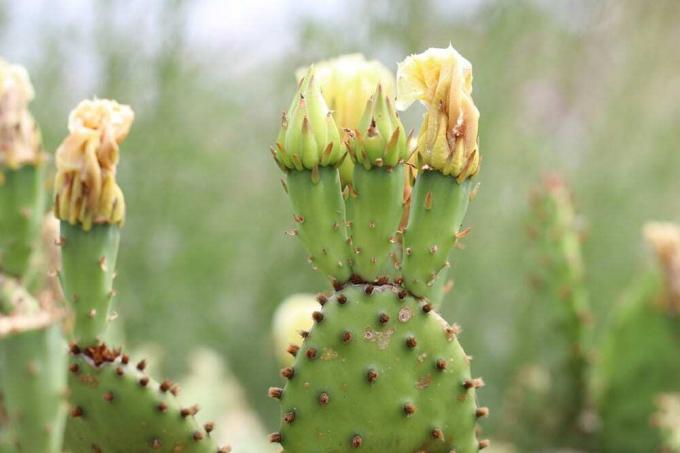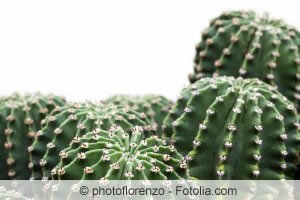

Table of contents
- Can all cacti bloom?
- Blooming cacti with spikes
- How do I get my cacti to bloom?
- What are leaf cacti?
- Flowering leaf cacti (almost) without thorns
- How do I care for leaf cacti?
Flowerless, prickly monsters eke out a desolate existence in some corners – just cacti. But there are alternatives. Magnificent flowers adorn inconspicuous green plants with or without spines and thorns - cacti are much prettier and more diverse than many a plant lover thinks. However, they do not bloom everywhere and without care they do not bloom at all.
Can all cacti bloom?
As far as their flowers are concerned, the cacti are very diverse and different. Some species only flower for a few hours or only at night, others at least for a few days. But in order for cacti to flower at all, they absolutely need a hibernation. However, this varies slightly depending on the type of cactus. The age of a cactus is also important. Some varieties do not flower until they are ten years old, others as early as the second or third year of life.
Blooming cacti with spikes

Echinopsis cinnabarina
- Origin: high altitudes of the Andes (South America)
- Growth: flattened spherical
- Diameter: up to 15 cm
- preferred location: bright
- flowers: bell-shaped to funnel-shaped, up to 4 cm in diameter, vermilion or scarlet
- Spines: 2 to 3 curved central spines; 8 to 12 slender radial spines, 0.6 to 1.2 cm long

Parodia microsperma
- Origin: Argentina
- Growth height: 5 to 20 cm
- Diameter: 5 to 10 cm
- preferred location: bright
- Flowers: yellow, orange or red, approx. 3 cm long, diameter approx. 4 to 5 cm
- Spines: 3 to 4 hooked central spines, reddish, brownish or blackish, 0.5 to 5 cm long; bristly or stiff radial spines, white, 0.4 to 0.8 cm long

silver candle
- botanical name: Cleistocactus strausii
- Origin: South America
- Growth height: approx. 1.3 m, mostly branched at the base
- Preferred location: sunny, like outside in summer
- Flower shape: tubular, approx. 8 to 12 cm long, never fully open
- Flower color: carmine
- Flowering time: only 5 to 6 days each
- Spines: each white, 2 cm long bristles and 4 strong light yellow central spines

Cereus
- botanical name: cereus
- other names: rock cactus
- Origin: South America
- Growth height: up to 10 m in nature, up to 1.5 m indoors
- preferred location: sunny
- Flowers: depending on the species, up to 35 cm long, white or red-white
- flowering time: at night
- Thorns: somewhat different depending on the species, tufted
devil pincushion
- botanical name: Ferocactus acanthodes
- Origin: Central America
- Growth height: up to 1.6 m in nature, up to 1 m in indoor culture
- Circumference: up to 1 m in nature, only approx. 30 cm, mostly cylindrical growth
- Preferred location: absolutely sunny (ensures beautiful thorn coloring)
- Flower color: yellow-reddish or green-yellowish
- Flowering time: rare when kept indoors, under good conditions from 10 or 15 cm in height
- Thorns: strong, hooked at the ends, red or red-yellow
How do I get my cacti to bloom?
If your cacti don't want to bloom, then maybe they're missing the winter rest they need. Some cacti simply need a light and cool place and little water during the dormant phase but no fertilizer. Other cacti require a little more cold (between about 8 °C and 15 °C) and a dry substrate during the dormant period. Here you should stop watering before moving to the winter quarters. Only in March do these cacti slowly get used to moisture again by spraying.
What are leaf cacti?
In contrast to "normal" cacti, the leaf cacti seem to have leaves. Appearances are deceptive, however, because they have no leaves but flat limbs or shoots. These limbs grow together, so leaf cacti don't actually have branches. However, some representatives of the leaf cacti have round or angular, stalk-like, relatively thin shoots. Most leaf cacti are considered thornless, instead they have bristles or even hair, which often fall off. However, there are some species with painfully stinging thorns.
Flowering leaf cacti (almost) without thorns

prickly pear
- botanical name: Opuntia ficus-indica
- Origin: America
- Growth height: 1 to 5 m, some varieties even up to 6 m under optimal conditions
- Preferred location: very bright, like direct sun
- Flower shape: up to 10 cm wide
- Flower color: yellow to red
- Flowering period: May to August
- Fruits: ovate, 6 to 10 cm long, yellow-green, orange or reddish, edible
- Taste of the fruit: like a mixture of pear and melon
- Special features: bizarre growth, there are also hardy varieties, bristle-like thorns, also on the fruits
rod cactus
- botanical name: Rhipsalis
- other names: rush cactus, coral cactus
- Origin: Brazilian rainforest
- Height of growth: hanging up to 2.5 m
- preferred location:
- Flowers: star-shaped and small, last only a few days, sometimes quite strong floral scent
- Flower color: white
- Flowering time: November to May
- Special features: different species with mostly slender, branched shoots

Easter cactus
- botanical name: Hatiora
- Origin: southern Brazil
- Growth height: 25 to 35 cm
- preferred location: bright, but without direct sunlight
- Flower shape: terminal bells
- Flower color: white, pink, red or orange
- Flowering time: March to May
- Special features: grows bushy and overhanging

cobbler cactus
- botanical name: Disocactus ackermannii
- Origin: Mexico
- Height of growth: overhanging, up to 1 m
- preferred location: bright
- Flower shape: funnel-shaped, 11 to 14 cm long
- Flower color: scarlet, green throat

Christmas cactus
- botanical name: Schlumbergera
- Origin: Brazilian coastal forests
- Growth height: up to 40 cm
- preferred location: sunny, but without direct midday sun, in summer like outside in the semi-shade
- Flower shape: oblong, pushed into one another like scales, inflorescences up to 10 cm long
- Flower color: white, pink, red, yellow or orange
- Flowering time: November to January
- Special features: prefers neutral soil, has fine bristles, only forms buds when it has been dark for long enough
Tip:
Easter and Christmas cacti look very similar, but not only differ in their flowering time. In contrast to those of the Christmas cactus, the branches of the Easter cactus are not perforated.
How do I care for leaf cacti?
Most leaf cacti prefer slightly acidic, moderately dry to fresh soil. They are sensitive to lime, so they should not be watered with very hard tap water. Ideally, you water your leaf cacti with clean rainwater, alternatively with stale or softened tap water. Unlike "real" cacti, they usually come from forests, where they grow on trees, but not in direct sunlight. Accordingly, they prefer slightly shady locations. A hibernation is also good for these cacti.
 Home editorial office
Home editorial office
Learn more about succulents

Aloe vera flowers: photo | use of the flowers
The aloe vera is a decorative, frugal and practical plant for the balcony and the house. But not only their leaves can be used, the unusual flowers also offer advantages and can be used in many ways.

Aloe species: 29 varieties | Edible aloe vera
The aloe is one of the Mediterranean succulents that are easy to care for both in the garden and on the windowsill. The best-known variety is aloe vera, which is also used as a medicinal plant. Other beautiful aloe varieties are presented here.

Triangular spurge: care and pruning of the cactus
The Triangular Spurge is a succulent plant that is ideal for indoor cultivation. In appearance, this exotic resembles cacti, as well as in care. Due to the poisonous plant sap, special protective measures are required when cutting to avoid symptoms of poisoning.

Rhipsalis cassutha: is it poisonous? Instructions for care and propagation
Also known as the coral or rod cactus, the Rhipsalis cassutha is an extravagant, robust and easy-care houseplant. The special thing about this cactus is its filigree, hanging and strongly branched shoots. The many small white flowers are also pretty to look at.
Queen of the Night Cactus - Caring for Selenicereus grandiflorus
The Queen of the Night does not bear her name wrongly, because the fascinating blooming splendor of older plants is a special feature. If you want to experience the flowering, which only lasts a few hours, you can cultivate Selenicereus grandiflorus in your own home without much effort. Read more about the care needs of the plant.

Echinopsis Cacti - Species/Variety and Care Tips
Many a passion for collecting began with a cactus of the genus Echinopsis. The cacti, which are spherical at first but become columnar when they are older, enchant with their wonderful blossoms and beguiling scent. Immerse yourself in the multifaceted world of Echinopsis cacti and get to know the most beautiful types and varieties, including useful care tips.



